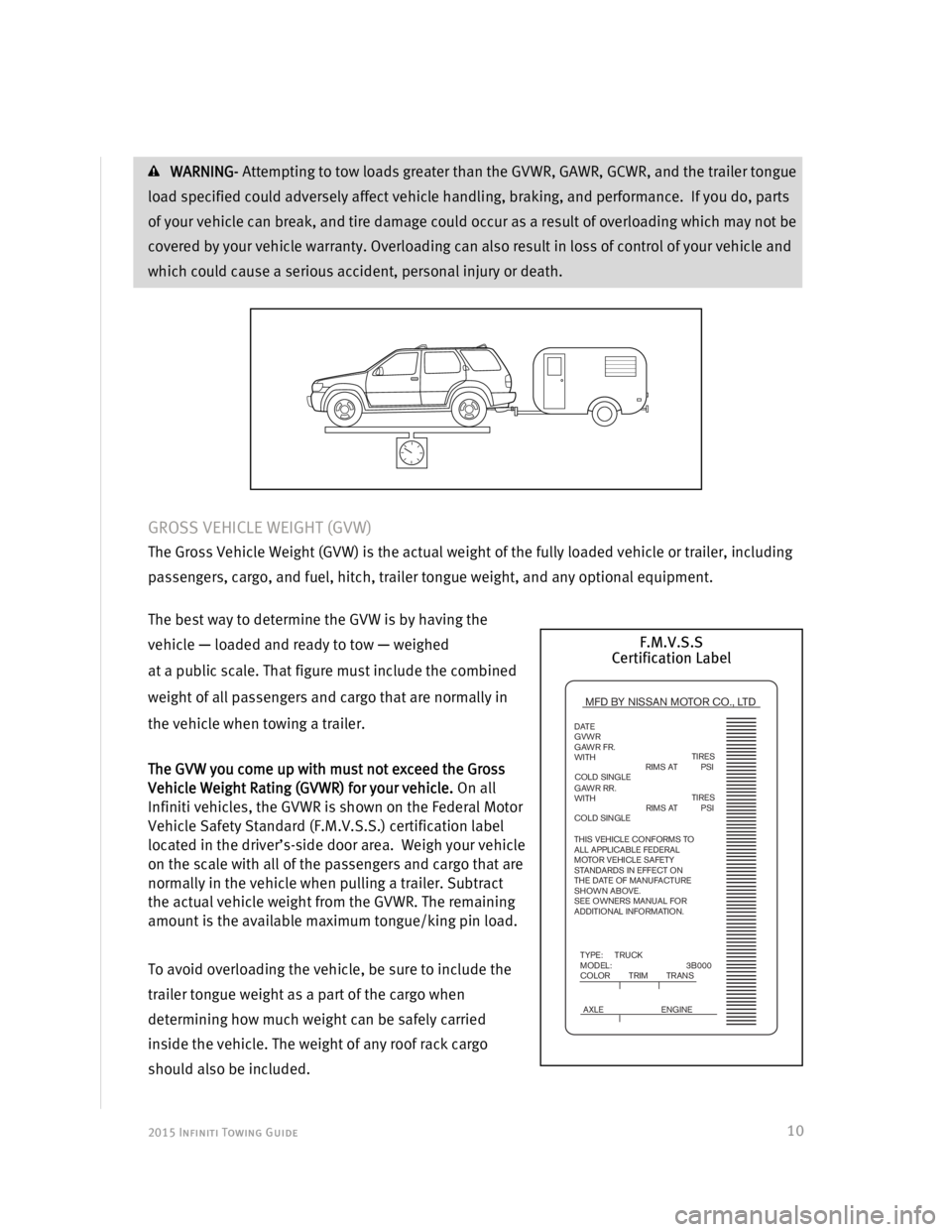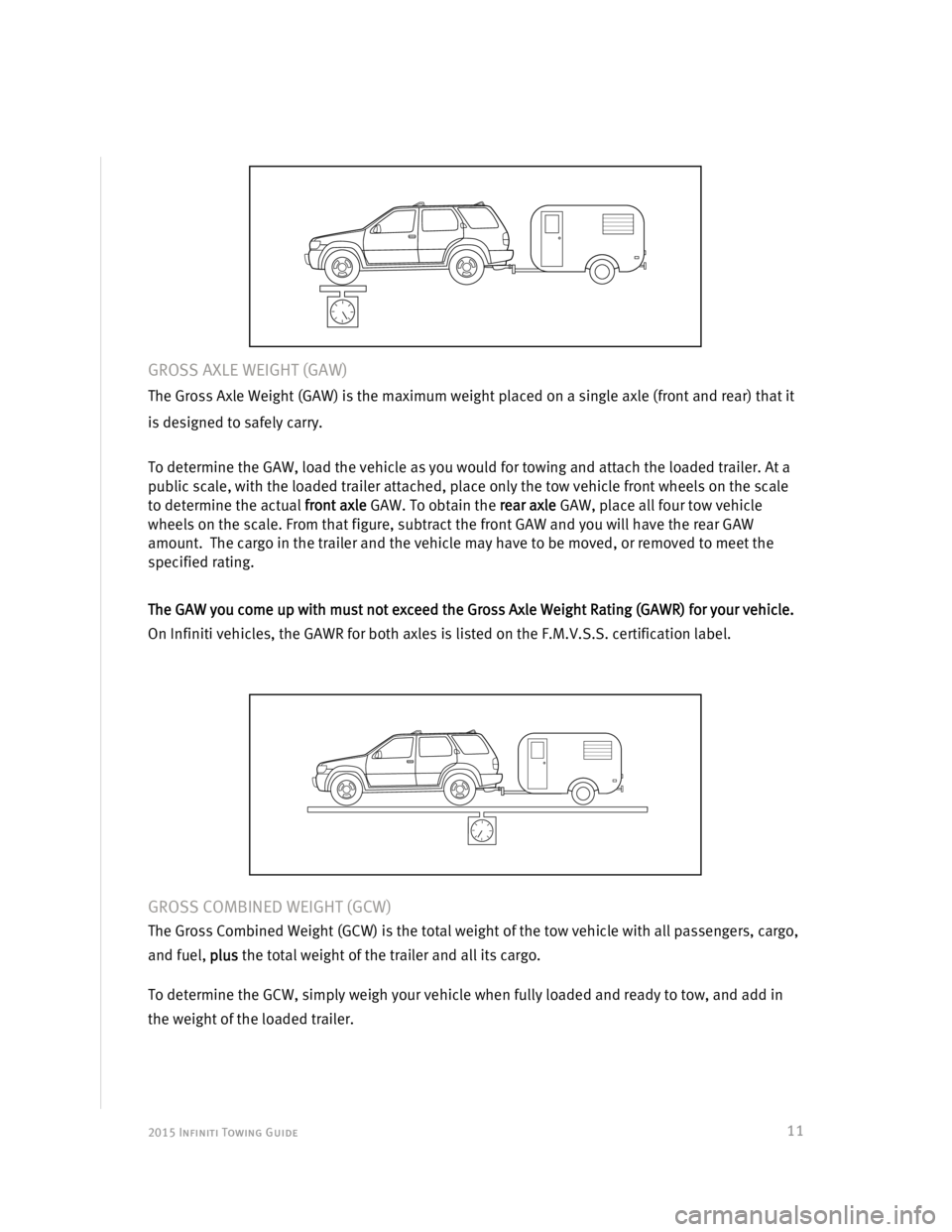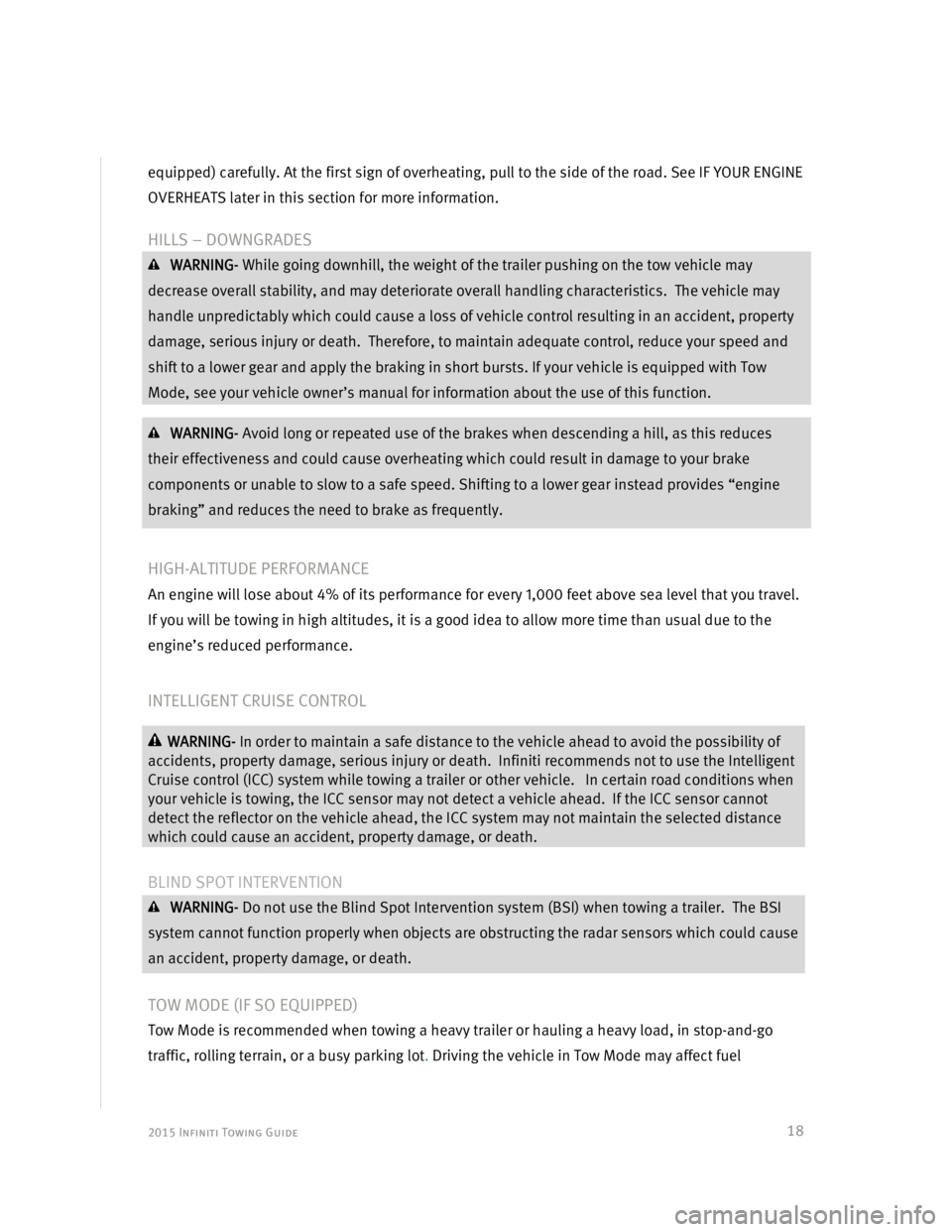fuel INFINITI QX80 2015 Towing Guide
[x] Cancel search | Manufacturer: INFINITI, Model Year: 2015, Model line: QX80, Model: INFINITI QX80 2015Pages: 25, PDF Size: 0.42 MB
Page 11 of 25

2015 Infiniti Towing Guide
10
WARNING- Attempting to tow loads greater than the GVWR, GAWR, GCWR, and the trailer tongue
load specified could adversely affect vehicle handling, braking, and performance. If you do, parts
of your vehicle can break, and tire damage could occur as a result of overloading which may not be
covered by your vehicle warranty. Overloading can also result in loss of control of your vehicle and
which could cause a serious accident, personal injury or death.
GROSS VEHICLE WEIGHT (GVW)
The Gross Vehicle Weight (GVW) is the actual weight of the fully loaded vehicle or trailer, including
passengers, cargo, and fuel, hitch, trailer tongue weight, and any optional equipment.
The best way to determine the GVW is by having the
vehicle — loaded and ready to tow — weighed
at a public scale. That figure must include the combined
weight of all passengers and cargo that are normally in
the vehicle when towing a trailer.
The GVW you come up with must not exceed the Gross
Vehicle Weight Rating (GVWR) for your vehicle. On all
Infiniti vehicles, the GVWR is shown on the Federal Motor
Vehicle Safety Standard (F.M.V.S.S.) certification label
located in the driver’s-side door area. Weigh your vehicle
on the scale with all of the passengers and cargo that are
normally in the vehicle when pulling a trailer. Subtract
the actual vehicle weight from the GVWR. The remaining
amount is the available maximum tongue/king pin load.
To avoid overloading the vehicle, be sure to include the
trailer tongue weight as a part of the cargo when
determining how much weight can be safely carried
inside the vehicle. The weight of any roof rack cargo
should also be included.
MFD BY NISSAN MOTOR CO., LTD
DATE
GVWR
GAWR FR.
WITH
GAWR RR.
WITH
THIS VEHICLE CONFORMS TO
ALL APPLICABLE FEDERAL
MOTOR VEHICLE SAFETY
STANDARDS IN EFFECT ON
THE DATE OF MANUFACTURE
SHOWN ABOVE.
SEE OWNERS MANUAL FOR
ADDITIONAL INFORMATION.
TIRES
TIRES
TYPE: TRUCK
MODEL: 3B000
COLOR TRIM TRANS
AXLE ENGINE
RIMS AT PSI
COLD SINGLERIMS AT PSI
COLD SINGLE
F.M.V.S.S
Certification Label
Page 12 of 25

2015 Infiniti Towing Guide
11
GROSS AXLE WEIGHT (GAW)
The Gross Axle Weight (GAW) is the maximum weight placed on a single axle (front and rear) that it
is designed to safely carry.
To determine the GAW, load the vehicle as you would for towing and attach the loaded trailer. At a
public scale, with the loaded trailer attached, place only the tow vehicle front wheels on the scale
to determine the actual front axle GAW. To obtain the rear axle GAW, place all four tow vehicle
wheels on the scale. From that figure, subtract the front GAW and you will have the rear GAW
amount. The cargo in the trailer and the vehicle may have to be moved, or removed to meet the
specified rating.
The GAW you come up with must not exceed the Gross Axle Weight Rating (GAWR) for your vehicle.
On Infiniti vehicles, the GAWR for both axles is listed on the F.M.V.S.S. certification label.
GROSS COMBINED WEIGHT (GCW)
The Gross Combined Weight (GCW) is the total weight of the tow vehicle with all passengers, cargo,
and fuel, plus the total weight of the trailer and all its cargo.
To determine the GCW, simply weigh your vehicle when fully loaded and ready to tow, and add in
the weight of the loaded trailer.
Page 19 of 25

2015 Infiniti Towing Guide
18
equipped) carefully. At the first sign of overheating, pull to the side of the road. See IF YOUR ENGINE
OVERHEATS later in this section for more information.
HILLS – DOWNGRADES
WARNING- While going downhill, the weight of the trailer pushing on the tow vehicle may
decrease overall stability, and may deteriorate overall handling characteristics. The vehicle may
handle unpredictably which could cause a loss of vehicle control resulting in an accident, property
damage, serious injury or death. Therefore, to maintain adequate control, reduce your speed and
shift to a lower gear and apply the braking in short bursts. If your vehicle is equipped with Tow
Mode, see your vehicle owner’s manual for information about the use of this function.
WARNING- Avoid long or repeated use of the brakes when descending a hill, as this reduces
their effectiveness and could cause overheating which could result in damage to your brake
components or unable to slow to a safe speed. Shifting to a lower gear instead provides “engine
braking” and reduces the need to brake as frequently.
HIGH-ALTITUDE PERFORMANCE
An engine will lose about 4% of its performance for every 1,000 feet above sea level that you travel.
If you will be towing in high altitudes, it is a good idea to allow more time than usual due to the
engine’s reduced performance.
INTELLIGENT CRUISE CONTROL
WARNING- In order to maintain a safe distance to the vehicle ahead to avoid the possibility of
accidents, property damage, serious injury or death. Infiniti recommends not to use the Intelligent
Cruise control (ICC) system while towing a trailer or other vehicle. In certain road conditions when
your vehicle is towing, the ICC sensor may not detect a vehicle ahead. If the ICC sensor cannot
detect the reflector on the vehicle ahead, the ICC system may not maintain the selected distance
which could cause an accident, property damage, or death.
BLIND SPOT INTERVENTION
WARNING- Do not use the Blind Spot Intervention system (BSI) when towing a trailer. The BSI
system cannot function properly when objects are obstructing the radar sensors which could cause
an accident, property damage, or death.
TOW MODE (IF SO EQUIPPED)
Tow Mode is recommended when towing a heavy trailer or hauling a heavy load, in stop-and-go
traffic, rolling terrain, or a busy parking lot. Driving the vehicle in Tow Mode may affect fuel
Page 22 of 25

2015 Infiniti Towing Guide
21
TOWING GLOSSARY
BALL MOUNT A bar that holds the hitch ball and is inserted into the hitch receiver. Also
commonly called a drawbar.
BREAKAWAY SWITCH A safety device using a trailer battery that automatically applies the trailer’s
brakes if it should accidentally become separated from the tow vehicle. A
breakaway switch may be used with both electric or surge trailer brake systems.
BUMPER HITCH A reinforced bumper designed to accommodate a hitch ball.
ELECTRIC TRAILER BRAKES When the brakes on a tow vehicle are applied, an electric current is sent to an
actuator which applies the trailer’s brakes.
ELECTRIC TRAILER BRAKE CONTROLLER A device that controls the electric trailer brakes.
GROSS AXLE WEIGHT RATING (GAWR) The maximum amount of weight each vehicle axle (front and rear) is designed to
safely carry.
GROSS COMBINED WEIGHT RATING (GCWR) The maximum allowable combined weight of the vehicle and trailer, including
passengers and all cargo.
GROSS VEHICLE
WEIGHT RATING (GVWR) The maximum allowable weight of the vehicle, including passengers, cargo, fuel,
hitch, trailer tongue load, and any optional equipment.
HITCH BALL
A ball that connects the trailer to the tow vehicle hitch that provides the means
by which the trailer pivots during cornering. Available in a number of sizes and
weight capacities, it must correspond to the trailer coupler size, and have a
sufficient capacity rating for the trailer being pulled.
RECEIVER HITCH A frame- or structure-mounted hitch with a receiver that allows removal of the ball
mount.
SAFETY CHAINS/CABLES Provides an emergency connection between the tow vehicle and the trailer,
should the trailer become disengaged for any reason.
SURGE BRAKES
Hydraulic-type braking system activated by inertia. As the tow vehicle begins to
brake, the trailer pushes against the hitch ball, consequently activating the trailer
brakes.
TRAILER TONGUE/COUPLER The part of the trailer that extends forward to meet the tow vehicle, and carries
the coupler assembly.
TRAILER TONGUE
LOAD The amount of trailer weight pressing down on the hitch.
WEIGHT-DISTRIBUTING
HITCH SYSTEM Type of hitch system that helps shift the trailer tongue weight to all trailer tires
and the tow vehicle front tires. Strongly recommended when towing trailers with a
Maximum Trailer Weight greater than 5,000 lbs.
WIRING HARNESS
Provides an electrical connection linking the tow vehicle’s electrical system to the
trailer’s system.